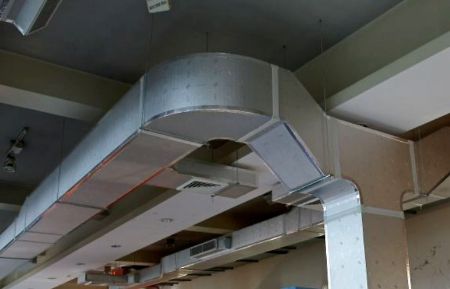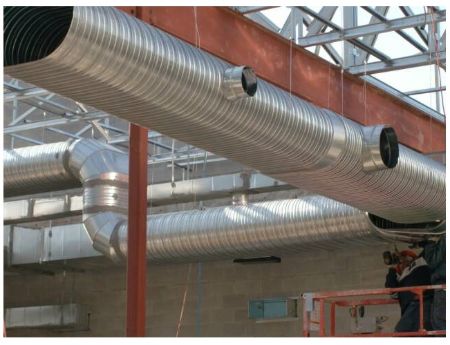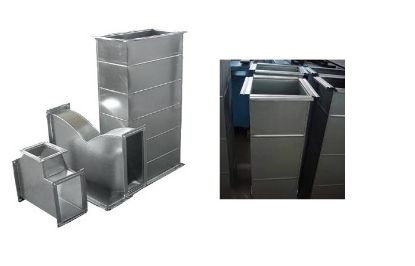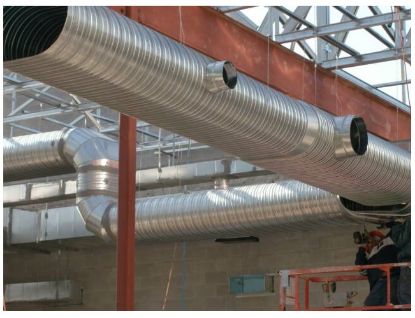Duct
Conditioned air is distributed to different parts of the building through ductwork. Irrespective of the size and shape of the building, duct lines of right size and shape are installed to distribute the air to all areas within a given building. In a large HVAC project such as for malls, office buildings, hospitals, warehouses, exhibition centers, cold storages, the duct is typically connected to an AHU at one end and dampers/grills are installed at the other end to supply conditioned air to various parts of the building. However, in a small HVAC project such as for showrooms, restaurants, clinics, startup offices, fitness centers, food courts, the duct can be connected to an Air Handling Unit or Fan Coil Unit or Indoor unit at one end and to a grill at the other end. Ducting work involves a supply line and a return line. Through the supply line, conditioned air is delivered, whereas through the return line, stale air from all parts of the building is sucked. This stale or unclean air passes through a filtering stage in an AHU and then clean conditioned air is supplied through the supply line.

Ductwork is also an integral part of ventilation projects wherein fans are installed and through duct lines fresh air is circulated to keep the building ventilated. Exhaust fans of different capacities suck the stale air and smoke and through duct lines smoke and unclean air are discharged into the atmosphere. This way a building is kept properly ventilated. Ventilation projects are typically implemented in basements, parking areas, lift lobby areas, workshops, industrial plants, food courts, eating joints, etc. Ventilation projects are carried out in commercial as well as residential buildings. Therefore, ducting work is incorporated in all kinds and sizes of buildings.
Duct material
A typical duct is made of a GI sheet. The sheet thickness is measured in gauge. There are a variety of GI sheets available in the Indian HVAC industry ranging from 26 gauge to 16 gauge. However, typically, 24 gauge (0.63 mm sheet) and 22 gauge (0.8 mm sheet) are dominantly used in HVAC applications across India. The sheet thickness is chosen based on the application of the HVAC system. If, for example, pressurization in the lift lobby area is the scope of the project, then, in that case, generally, a 22 gauge sheet is chosen to withstand the flow of high pressure air being supplied from high air volume fans with relatively higher static pressure. Whereas, a 24 gauge sheet is chosen when conditioned air is supplied to different parts of the building through an AHU. Again, the choice of duct sheet is dependent on the HVAC design. Since, ducting work can run in thousands of square meters, therefore, the choice of ducting sheet plays an important role in the overall cost of the HVAC system. Generally, a 24 gauge sheet should serve the purpose, however, wherever high air pressure is desired, a 22 gauge sheet should be able to serve the purpose. Jindal and Tata Steel are the leading suppliers of GI sheets to the Indian HVAC industry.
What shape of the duct should be chosen?
An air duct can be rectangular or circular or oval / spiral in shape. Rectangular ducts are the most commonly used ducts in the Indian HVAC market. Rectangular ducts can either be factory fabricated or made at the site. Rectangular ducts are the most affordable ducts available in the market. Circular or oval ducts are factory fabricated. These circular or oval / spiral ducts are relatively more expensive to fabricate than the rectangular ducts. In addition to the cost, the aesthetic and HVAC design should determine the correct shape of the duct for any given HVAC project. However, from the efficiency point of view, circular or oval ducts are chosen. This is clearly explained by some basic calculations.
Let’s take an example: a rectangular duct measuring 2.25 feet in width and 1-foot height provides 2.25 square feet of area for airflow. However, the perimeter of this duct comes out to be (2.25*2 + 1*2 = 6.5) 6.5 feet. Now, to achieve the same area of 2.25 square feet, the circular duct will require a radius of 0.846 Feet. With this radius, the perimeter comes out to be (3.14*2*0.846 = 5.32) 5.32 feet. Therefore, it is clearly evident that to achieve the same area for the airflow, the perimeter in the case of the circular duct is less than the perimeter in the case of the rectangular duct. Why does the perimeter matter? The higher the perimeter, the greater the turbulence when it comes to airflow. Therefore, go for the circular duct whenever possible. Circular duct results in improved efficiency in an HVAC system thereby reducing the energy bill. Opt for the rectangular duct only when there is a lack of space for the circular duct.
It is clearly evident from the above example that circular ducts are much more efficient than the rectangular ducts. However, choice of ducting depends on various factors such as aesthetic, cost, and efficiency. Largely, for large scale ventilation projects, rectangular ducts are chosen. Whereas, in certain HVAC applications, wherever ducting is visible across the building, aesthetics is the dominant factor and therefore circular or oval ducts are chosen. However, in such applications wherever ducting is visible, the need for duct insulation arises. AC ducts are then insulated from inside. Generally 13 mm thick nitrile is used to insulate the AC ducts. This also adds to the overall cost of the HVAC project.
Installation
Installation of the duct lines is carried out in accordance with the drawings that are made as part of the HVAC design. The design engineer supervises the entire process. Neoprene gaskets, elbows , bends, vanes, hangers, splitter dampers, supports, nuts/bolts, fasteners, etc. complete the installation kit for ductwork. Once the duct installation is completed, cuts are made in the duct line as per the specifications in the drawings. Thereafter, dampers and grills are installed to allow for airflow in the building.
The design team at TheSmartHVAC prepares the comprehensive HVAC design keeping in mind the overall cost of the project, aesthetic, and efficiency.
Appropriate shape and size of ducts are chosen. TheSmartHVAC works with some of the leading duct manufacturers in India. For example, Dustech, Zeco, and Samco are the preferred partners in the Delhi NCR region. Whereas Shree Venus is the preferred partner in Chennai and other southern parts of the country. Other preferred companies are Rolastar, sever star, and western air duct to serve other regions such as Mumbai, Pune, Bengaluru, Hyderabad.
TheSmartHVAC is open to partnering with many other duct manufacturers. These companies can contact us at [email protected]




